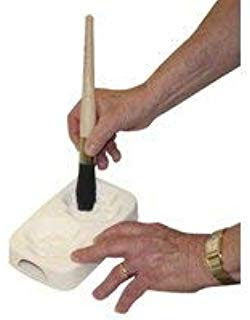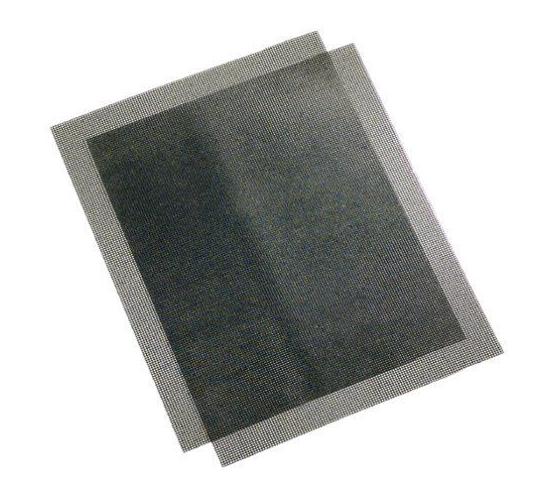Glass separators tend to be in three forms – powdered, liquid or fibre. These are applied to shelves, moulds and other surfaces that might come
into contact with the hot glass.
What do they do?
Glass separators keep the glass from sticking to the shelves,
kiln furniture and other supports during the higher temperature parts of
the firing. Glass as used for
kilnforming reaches its softening point somewhere around 580°C. The glass will begin to stick to all surfaces
as it gets warmer. The separators are
stable at high temperatures and do not stick to the glass or the materials used to separate
the glass from its supports.
What are they?
Liquid and
powder separators are most often called kiln wash - or batt wash in the
ceramics field. Normally they are
supplied in powder form that is mixed with water for painting onto shelves and
moulds.
They normally have a high content
of alumina hydrate, some kaolin (also known as china clay) and sometimes a
little silica, plus often a colouring agent that burns away on the first firing
to indicate fired and unfired shelves.
A high
temperature lubricant, boron nitride, has come into use for kilnforming and has
slightly different characteristics than the alumina hydrate-based kiln washes.
Sheet and blanket forms of glass
separators are also widely used. They
have the general name of refractory mineral wool. They are often made from alkaline
earth silicate (AES) wool, Alumino silicate wool (ASW) and Polycrystalline wool (PCW). These have different temperature ranges and
levels of health risk. The
thin sheets are mainly used for covering shelves and other kiln
furniture. The blanket, which starts at
about 12mm, is used mainly for insulation purposes.
Thin papers, similar in thickness to cartridge paper have
been developed to give a finer texture than mineral wool separators. These currently have the trade names Papyros
and Thinfire, each with their own slightly different characteristics.
Safety
As with all refractory materials, safety precautions are
needed. In the kilnforming world the
risks are not those of the industrial environment because the quantities are
less, and the time of exposure is much less.
Still, breathing protection should be used. Eye protection is advisable,
as the particles are hard and can scratch the eye surface. Long sleeves and gloves are advisable when
handling refractory fibres.
Kiln Wash
This blog concentrates on liquid and powdered separators. It
draws on information from the ceramics and kilnforming communities.
Basic Kiln Wash Materials
A lot of the kilnforming knowledge of glass
separators comes from the ceramics field. A brief look at the development of
kiln wash by ceramicists is instructive to kilnforming.
In
order to make a good kiln wash you need to select materials that have very high
melting points and that, when combined, do not create a eutectic that
causes melting. Knowing a bit about the properties of materials and the
principles of kiln wash allows you to choose the ingredients that make the best
wash for your specific situation and avoid costly problems.
The basic materials started as:
EPK Kaolin (which
includes alumina) 50%
Silica 50%
EPK Kaolin is a high quality, water washed kaolin which
is white, has unusually good
forming characteristics and high green strength. In
mixtures, EPK offers excellent suspension capabilities. The source of alumina in kiln wash was often
kaolin, but now is most often alumina hydrate or alumina oxide.
Silicon
dioxide has a melting point of 1710°C and aluminium oxide has a melting point of 2050°C.
A mixture of these two materials will not melt, and will protect the
kiln shelves at high temperatures.
This
is a good kiln wash for low and mid-range electric firings [for ceramics]. The
only problem is that it contains silica, which is a glass-former. So, if a lot
of glaze drips onto the shelf, it can melt the silica in the kiln wash and form
a glaze on the shelf. Also, when you scrape your shelves to clean them, you
create a lot of silica dust, which is a known carcinogen. So, using silica in
your kiln wash is not … the best choice.
Another
drawback of this recipe is that, if it is used in salt or soda firings, it will
most certainly create a glaze on the shelf. This is because silica, as noted
above, is a glass-former. When sodium oxide, which is a strong flux, is
introduced atmospherically, it can easily melt the silica in the kiln wash into
a glass. This is why silica should not be used in a kiln wash recipe for wood,
salt or soda kilns.
For glaze firings a kiln wash with more separator and
less glass former is better:
Alumina hydrate 50%
EPK kaolin 50%
Kaolin
has a melting point of 1770°C and alumina oxide has a melting point of 2050°C,
so it will not melt, even in a … firing [of 1250°C to 1350°C]. These
ingredients are called refractory because they are resistant to high
temperatures. … This recipe can be used at all temperatures and in all kiln
atmospheres.
Kiln washes with kaolin, especially if applied thickly,
can flake off the shelf after repeated firing.
The cause of this is the shrinking of the drying kaolin - which is a
clay – similar to dried out lake beds. Adding at least half the kaolin as
calcined EPK kaolin reduces this shrinkage. Calcining involves drying the
kaolin at about 1000°C for some time.
This reduces the physical property of shrinkage, but retains the
chemical and refractory properties of a glass separator intact.
This gives a kiln wash consisting of:
Alumina hydrate 50%
Calcined EPK kaolin 25%
EPK kaolin 25%
You can add more calcined kaolin – up to 35% – if you
want. You need to keep enough un-calcined kaolin in the recipe to suspend the
other materials so that the suspended materials can be applied smoothly. One difficulty of increasing the kaolin
content of the kiln wash is that it tends to stick to the glass - especially
opalescent - on a second firing.
It is, of course, possible to do away with the kaolin
entirely. You can mix alumina hydrate
with water into a full milk consistency and apply that to the shelf or other
kiln furniture. It is difficult to maintain the alumina hydrate in suspension, though. After the firing you can
brush the dried separator from the shelf into a container for re-use. You do need to ensure that the powder to be reused is free
of contaminants. It is also important to
find very fine grades of the alumina hydrate to minimise the texture on the
base of the glass. Most ceramic grades
are coarser than wanted for kiln forming.
You can put the powder in a rock tumbler to make what you find finer
than as purchased.
There
are many variations on these basic kiln wash recipes. To illustrate the wide
variety, some potters just dust alumina hydrate on their shelves to protect
them, while some wood firing potters use 100% silica and wall paper paste to
make a very thick (1/2-inch) coating that protects their shelves from excessive
ash deposits. Still others, who have the new advanced nitride-bonded silicon
carbide shelves, don’t even use kiln wash at all because the glaze drips shiver
off when the shelves cool. Other potters, who are very neat and don’t share
their space with others, may not even use kiln wash so that they can flip the
shelves after every firing to prevent warping.
Kiln
wash is such a ubiquitous material in the ceramics studio that we take it for
granted. … There are many recipes to choose from and many solutions to common
problems if we just take the time to learn about the materials we use.
Variants on the traditional glass separators
There are variations in the use of alumina hydrate and
kaolin, but there are also other glass separators available, although they tend
to be expensive.
An example is zirconium. It is a glass separator with
refractory properties, as in its zirconium oxide form it melts 2700°C. In its zirconium silicate form it has a
melting point of 2550°C. These are
available under a number of trade names. This can be added to the kiln wash mix
in the knowledge that it will be stable throughout the firing.
But you must be careful in the amount you use, as
zirconium silicate is used as an opacifier in glass and glazes. Also, zirconium oxide is one of the hardest
substances in the world.
Another very popular glass separator is boron nitride. It has two forms.
One is cubic boron nitride, a cubic structure similar to
diamonds.
In
the cubic form of boron nitride, alternately linked boron and nitrogen atoms
form a tetrahedral bond network, exactly like carbon atoms do in diamond. Cubic boron nitride is extremely hard and will
even scratch diamond. It is the second hardest material known, second only to
diamond. Cubic boron nitride has very
high thermal conductivity, excellent wear resistance and good chemical
inertness, all very useful properties for a material subjected to extreme
conditions. Because of its hardness, chemical inertness, high melting
temperature (2973°C) cubic boron nitride is used as an abrasive and wear-resistant
coating. Cubic boron nitride (CBN) is used for cutting tools and abrasive
components for shaping/polishing with low carbon ferrous metals. (http://www.docbrown.info/page03/nanochem06.htm)
Hexagonal Boron Nitride
The second form, useful in kilnforming is the hexagonal form
of boron nitride. It forms white plates
of hexagons one layer thick like graphite.
These plates have weak bonds and so slide easily against one another.
It is a good insulator and chemically very inert. It is stable to about 2700°C.
Hexagonal boron nitride (HBN) is used as a lubricant, since
the weakly held layers can slide over each other. Because of its 'soft' and 'slippery'
crystalline nature, and its high temperature stability, HBN is used in
lubricants in very hot mechanical working environments.
The slippery nature and high temperature stability characteristics make
this material an excellent coating for moulds and other situations where the glass
moves against its supports.
The coating of the moulds needs frequent re-coating because the layers slide from
the mould. Boron nitride works very well on solid impermeable surfaces as it
adheres easily to smooth surfaces. It can be used on porous surfaces, but does
seal those surfaces, meaning that these surfaces cannot be returned to that
porous state without significant abrasion.
-----
The next blog has notes on refractory mineral wools as separators and health and safety in use.






















